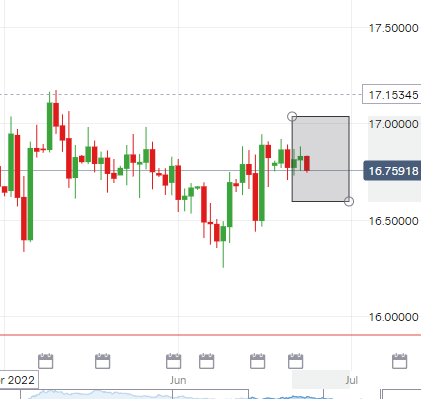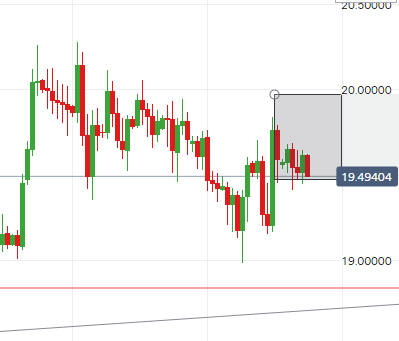OVERVIEW
Recession is on all investors minds and has caused a rift in the markets this week, trading side-ways with little volatility. Central Banks stay head on to raise interest rates in order to tackle inflation despite global growth woes.
u.s and sa markets
The Dollar market has been choppy this week as recession fears are prevalent with investors betting on another 75 basis point hike in July. FED Chair Jerome Powell had a testimony and told the Senate on Wednesday that the risk of recession has definitely increased but the FED is determined to focus on cooling the highest inflation of this generation. The U.S central bank will likely return to 25 basis point hikes in September depending on CPI data at the time.
The U.S Initial Jobless Claims fell from 231,000 to 229,000 signalling that the labour market is showing signs of cooling. Crude oil has found a level of resistance at the $120 bpd and has started weakening and is trading around $105 bpd this morning as shortage of demand increases, furthermore the global recession fears caused a major sell-off in the oil market.
Locally, We have officially been moved to stage 4 of load shedding as of 11:00am to midnight
Of recent, protests have been staged outside nine of Eskom’s power stations, blocking routes leading to the power stations as frustrations of the public and some employees run high. Eskom has warned that we could see higher stages of load shedding due to protests which has been staged outside Health Minister Joe Phaahla lifted the mandatory use of face masks indoors and there is now no need to produce full vaccination certificates at South African borders as well.
The Bank of Mexico (Banxico) accelerated their pace with monetary policy tightening and has delivered their interest rate decision, hiking rates by 75 basis points in order to tame inflation which is currently at a 21-year high. Banxico has also warned that there will me more interest rates of a similar nature in the future. Could this mean South Africa is also in for a 75 basis point interest rate hike next month?
Technically:
The USD/ZAR remains range bound trading between highs of R16.09/$ and lows of R15.82/$. Despite being range bound, the pair is forming higher lows and lower highs forming a triangle in an upward trend, signaling a possible break-out next week. Should the pair break out lower, we may see lows of R15.71/$ next week. Should we break out to the up-side, the pair may test highs of R16.18/$
EUROPEAN MARKETS
European Central Bank President Christine Lagarde had a hearing on economic and monetary affairs of the European Parliament in Brussels on Monday. Lagarde touched up on the economic outlook of the Euro Zone mentioning that economic growth has been stunted due to high energy costs, supply shocks and uncertainty surrounding increased inflation. Projections reveal that inflation will remain uncomfortably high for some time, projected at 6.8% annual inflation before the projected decline to 3.5% in 2023. With this in mind, the ECB will be raising their interest rates at their next monetary policy meeting in July, by 25 basis points and in September as well.
Germany has triggered the alarm stage of their emergency gas plan. This comes after Russia halted gas supply to Russia with the claims that there were technical issues involved.
Technically:
The EUR/ZAR has been trading in an upward trend in the last 2 weeks, forming higher highs and higher lows. Although this week, much like the greenback, the pair has been trading sideways with little volume in the market, having seen a high of R16.91 on Monday and a low of R16.71 on Tuesday and trading between both point this week. Should the pair continue on its upward streak, the pair pay test a high of R17.03 next week. Should the pair break out lower, we may test lows of R16.61.
uk market
On Wednesday, the UK had their YoY Inflation data released and shows that CPI rose by 0.1% from 9.0% last month. Inflation continues to grapple the British as commodity and living costs continue to rise sharply.Furthermore, UK retail sales fell by 0.5% in May indicating a decrease in consumer spending, which is expected as food costs rise. This is also linked to fuel increases that rose by 1.1% adding more pressure to the public’s pocket.
Britain’s governing Conservative Party lost two important seats in Parliament during their elections, showing further no confidence in the current Prime Minister Boris Johnson. This result will likely revive further talks of a no confidence vote of Johnson.
Technically:
The GBPZAR has been trading in an upward channel since the 9th of June till today. This week, the pair traded between R19.40 and R19.68 with low volume. Should price action remain dominant over fundamental data, we should expect strength in the Pound Sterling next week, testing a low of R19.46 and a possible high of R19.75.
Technical levels we are watching for next week:

USD/ZAR
High – R16.18/$
Support – R15.94/$
Low – R15.71/$
EUR/ZAR
High – R17.03/€
Support – R16.78/€
Low – R16.61/€


GBP/ZAR
High – R19.75/£
Support – R19.57/£
Low – R19.46/£



